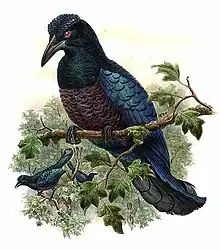Curl-crested manucode
The curl-crested manucode (Manucodia comrii) is a large bird of paradise, about 43 cm long, with glossy purple, black and green plumage, red iris and crinkled yellowish-green upper breast and neck feathers. It has curled head feathering and twisted central tail feathers. It is the largest species in its family,[2] though its tail is shorter than the black sicklebill.
| Curl-crested manucode | |
|---|---|
 | |
| Illustration of Manucodia comrii | |
| Scientific classification | |
| Domain: | Eukaryota |
| Kingdom: | Animalia |
| Phylum: | Chordata |
| Class: | Aves |
| Order: | Passeriformes |
| Family: | Paradisaeidae |
| Genus: | Manucodia |
| Species: | M. comrii |
| Binomial name | |
| Manucodia comrii Sclater, 1876 | |
It is found in the Trobriand Islands and islands of the D'Entrecasteaux Archipelago. This species is also one of the largest and heaviest among birds of paradise. They eat fruits.
The British zoologist Philip Lutley Sclater named this species after Peter Comrie, who discovered the bird at Fergusson Island in 1874.
References
- BirdLife International (2012). "Manucodia comrii". IUCN Red List of Threatened Species. 2012. Retrieved 26 November 2013.
- Perrins, Christopher, Firefly Encyclopedia of Birds. Firefly Books. ISBN 1-55297-777-3
- BirdLife International (2004). Manucodia comrii. 2006 IUCN Red List of Threatened Species. IUCN 2006. Retrieved on 30 October 2006. Database entry includes a lengthy justification of why this species is of least concern
- audio recording of this bird at the Cornell Lab of Ornithology
This article is issued from Wikipedia. The text is licensed under Creative Commons - Attribution - Sharealike. Additional terms may apply for the media files.
